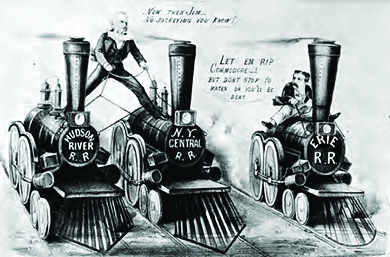| << Chapter < Page | Chapter >> Page > |
Jay Gould was perhaps the first prominent railroad magnate to be tarred with the “robber baron” brush. He bought older, smaller, rundown railroads, offered minimal improvements, and then capitalized on factory owners’ desires to ship their goods on this increasingly popular and more cost-efficient form of transportation. His work with the Erie Railroad was notorious among other investors, as he drove the company to near ruin in a failed attempt to attract foreign investors during a takeover attempt. His model worked better in the American West, where the railroads were still widely scattered across the country, forcing farmers and businesses to pay whatever prices Gould demanded in order to use his trains. In addition to owning the Union Pacific Railroad that helped to construct the original transcontinental railroad line, Gould came to control over ten thousand miles of track across the United States, accounting for 15 percent of all railroad transportation. When he died in 1892, Gould had a personal worth of over $100 million, although he was a deeply unpopular figure.
In contrast to Gould’s exploitative business model, which focused on financial profit more than on tangible industrial contributions, Commodore Cornelius Vanderbilt was a “robber baron” who truly cared about the success of his railroad enterprise and its positive impact on the American economy. Vanderbilt consolidated several smaller railroad lines, called trunk lines, to create the powerful New York Central Railroad Company, one of the largest corporations in the United States at the time ( [link] ). He later purchased stock in the major rail lines that would connect his company to Chicago, thus expanding his reach and power while simultaneously creating a railroad network to connect Chicago to New York City. This consolidation provided more efficient connections from Midwestern suppliers to eastern markets. It was through such consolidation that, by 1900, seven major railroad tycoons controlled over 70 percent of all operating lines. Vanderbilt’s personal wealth at his death (over $100 million in 1877), placed him among the top three wealthiest individuals in American history.

The post-Civil War inventors generated ideas that transformed the economy, but they were not big businessmen. The evolution from technical innovation to massive industry took place at the hands of the entrepreneurs whose business gambles paid off, making them some of the richest Americans of their day. Steel magnate Andrew Carnegie, oil tycoon John D. Rockefeller, and business financier J. P. Morgan were all businessmen who grew their respective businesses to a scale and scope that were unprecedented. Their companies changed how Americans lived and worked, and they themselves greatly influenced the growth of the country.

Notification Switch
Would you like to follow the 'U.s. history' conversation and receive update notifications?